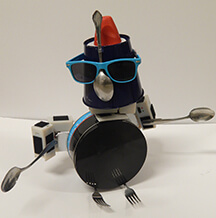System encourages creativity, makes robot-design fun
January 16, 2015
 |
|
This toy was created using a new cardboard-robotic toolkit that allows children to design and build custom robots they control wirelessly with hand gestures without formal education in programming or electronics. The system, called HandiMate, was developed by Purdue researchers and uses motorized "joint modules" equipped with wireless communicators and micro-controllers. (Purdue University photo/Ansh Verma) |
WEST LAFAYETTE, Ind. – A new cardboard-robotic toolkit allows children to create custom robots they control wirelessly with hand gestures without formal education in programming or electronics.
The system, called HandiMate, uses motorized "joint modules" equipped with wireless communicators and micro-controllers. Children create robots by using Velcro strips to attach the modules to any number of everyday materials and objects such as cardboard, metal cans and foam board. They then control the robots like puppets with a glove-based gesture controller.
"We have a series of simple hand gestures, and you map out how these gestures will control the different modules in your robot," said Karthik Ramani, Purdue University's Donald W. Feddersen Professor of Mechanical Engineering. "It brings out the creativity and imagination of the user. You don't have to learn programming or the electronics. Those things are in the background."
The modules rotate and bend, so they can be used to fashion a virtually unlimited variety of robots.
"You are coordinating six modules stuck together, and you map which gestures control specific modules to make the robot do what you want it to," he said. "One of the biggest problems in learning and education is getting children engaged. This helps to solve that problem because they get engaged and empowered, and thinking like engineers. They are designing and building but still having fun."
Information about the system is detailed in a paper to be presented during the ninth International Conference on Tangible, Embedded and Embodied Interaction Jan. 15-19 at Stanford University. The paper was authored by former Purdue graduate student Jasjeet Singh Seehra; graduate student Ansh Verma; Kylie Peppler, an assistant professor of learning sciences at Indiana University; and Ramani.
The researchers recruited 19 participants to test HandiMate - 12 college students and seven children ages 10-15 - and later gauged its performance with a questionnaire based on a "system usability scale" (SUS).
"Our focus is on learning," Peppler said. "For kids the average SUS score indicated a very high degree of usability."
All of the toys were created within 90 minutes. A HandiMate YouTube video shows children using the system.
"It provides a fun way for children to learn physics related to engineering design because physics is about motion and dynamics, statics, and mechanics and materials," Ramani said. "But instead of textbook learning, you actually experience it."
One teen came up with an innovative steering system for a wheeled robot. Another learned how to create a walking robot that remained stable at high speeds.
"Some of them really innovate," said Ramani, director of Purdue’s C Design Lab.
The glove makes it possible to control the creations remotely using only hand gestures.
"We call it embodied interaction because you almost feel like it is an extension of you," he said. "This technology is easy for the user, but behind the scenes are software algorithms that understand the user's gestures and coordinate the motion of several robotic joints."
ZeroUI Inc. in Cupertino, California, has purchased an exclusive licensing agreement through the Purdue Office of Technology Commercialization for the gesture-based technology developed in Ramani's laboratory.
ZeroUI founder and CEO Raja Jasti said HandiMate can lead to a new category of Internet of things (IoT) enabled robotic toys that appeal to both boys and girls.
"Affordable and powerful sensors, open source software and open IoT standards are powering a new generation of smart toy platforms such as HandiMate," he said. "We plan to launch a kickstarter campaign in 2015 to launch HandiMate as a gesture controllable robotic toy kit for kids."
Writer: Emil Venere, 765-494-3470, venere@purdue.edu
Sources: Karthik Ramani, 765-494-5725, ramani@purdue.edu
Kylie A. Peppler, 812-856-8381, kpeppler@indiana.edu
Raja Jasti , raja@zeroui.com
Related websites:
Karthik Ramani: https://engineering.purdue.edu/~ramani
Note to Journalists: An electronic copy of the research paper is available by contacting Emil Venere, 765-494-4709, venere@purdue.edu
ABSTRACT ONE
HandiMate: Create and Animate using Everyday Objects as Material
Jasjeet Singh Seehra1,Ansh Verma1,Kylie Peppler2,andKarthik Ramani1
1C Design Lab, Purdue University
2The Creativity Lab, Indiana University Bloomington
The combination of technological progress and a growing interest in design has promoted the prevalence of DIY (Do It Yourself) and craft activities. We introduce HandiMate, a platform that makes it easier for people without technical expertise to fabricate and animate electro-mechanical systems from everyday objects. Our goal is to encourage creativity, expressiveness and playfulness. The user can assemble his or hers handcrafted creations with HandiMate’s joint modules and animate them via gestures. The joint modules are packaged with an actuator, a wireless communication device and a micro-controller. This modularization makes quick electromechanical prototyping, just a matter of pressing together velcro. Animating these constructions is made intuitive and simple by a glove-based gestural controller. Our study conducted with children and adults demonstrates a high level of usability (system usability score - 79.9). It also indicates that creative ideas emerge and are realized in a constructive and iterative manner in less than 90 minutes. This paper describes the design goals, framework, interaction methods, sample creations and evaluations of our framework.

